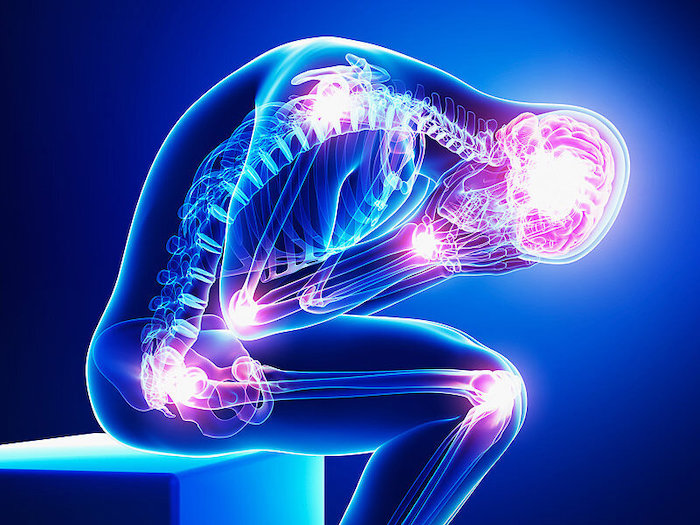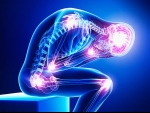
Find your sweet spot by learning how to push yourself, but not too far.
Acute pain is pain that indicates something is wrong. It has a specific precipitant (injury, infection, or illness) and subsides within a few days to about a month. In contrast, chronic pain is pain that is ongoing; with pain signals that serve no useful physiological purpose yet remain active in the nervous system for months and often years, with no end-point. It’s not unlike a smoke detector that becomes stuck in the “on” mode, continuously sounding a harrowing alarm at high volume. Chronic pain is a disorder unto itself.
Chronic pain conditions include but are certainly not limited to: back pain, arthritis pain, cancer pain, migraines, neurogenic pain (pain resulting from damage to nerves), and psychogenic pain (pain without any observable signs of damage or disease). Living with chronic pain can be a brutal, wearying experience. Physical effects include muscle tension, limited mobility, fatigue/lack of energy, sleep impairment, and changes in appetite. Depression, sadness, stress, frustration, irritability, anger, anxiety, and fear are common emotional effects.
This combination of physical and emotional impacts frequently results in a secondary challenge that affects people with chronic pain: lack of movement. Sometimes, you may struggle to mobilize the energy to move. Sometimes, it can feel like it hurts too much to move. Since the desire to protect oneself from pain is natural, often movement is minimized and avoided whenever possible. Sometimes, the fear that moving will create additional pain keeps people with chronic pain conditions stationary.
Inertia is a powerful force a stationary body tends to remain stationary the less you move, the less inclined you are to move.
Unfortunately, if you have chronic pain, the less you move, the more discomfort and pain you tend to have when you do move—incentivizing you to move even less. The more sedentary you are, the stiffer and weaker your body becomes and the more your physical functioning deteriorates. This can easily become a vicious circle that increasingly separates you from participating in activities ranging from the meaningful to the routine, and isolates you from the people in your life. As a consequence, your world becomes smaller and smaller. Sound familiar?
The Importance of Movement
Movement and exercise consistent with one’s capacity is an essential part of the chronic pain recovery process. Movement and exercise increase strength and enhance functional capacity. Physical movement is the body’s lubricant. In effect, motion is lotion—internally. Even movement as simple and low-impact as stretching can make a substantial positive difference.
As we age, our muscles and connective tissue tend to shorten and tighten, and joints become tighter and more rigid, lessening our range of motion. It’s more difficult to do what used to be easy, such as picking up something from the floor, kneeling, squatting, reaching for something over your head, or turning your head while backing out of a parking place. Obviously, these deficits are compounded when you have chronic pain.
Loosening your joints through slow gentle movement is a form of stretching. Joint movement is critical in facilitating the release and circulation of synovial fluid, a viscous liquid found in the cavities of the large joints in the body (e.g., the wrists, elbows, shoulders, hips, shoulders, knees, and ankles) that provides cushioning and lubrication to reduce internal friction. When these joints are stationary cartilage absorbs synovial fluid, but when they move synovial fluid is squeezed out of the cartilage, like water being wrung from a sponge.
Stretching helps keep the body specifically muscles, ligaments, tendons, and joints more limber and flexible.
Stretching can ease stiffness, increase range of movement, reduce stress on joints, and increase the flow of blood and nutrients throughout the body. Moreover, these benefits have benefits—such as decreasing the risk of injury and helping to reduce overall levels of pain. Stretching is the best way to prepare your body for all other forms of physical activity.
Finding The Sweet Spot
Because moving can be so challenging for people with chronic pain it’s important to be consciously aware of the need to move your body through various forms of physical activity, and to push yourself—though not too far. You can learn how to go beyond the limiting boundaries of your comfort zone, and through practice find the sweet spot between not doing enough and doing too much.
That sweet spot is a moving target, as your physical status and capacity of people with chronic pain can vary from day to day, hour to hour, and even moment to moment. Therefore, locating it requires an ongoing and attuned self-assessment. It is a day-to-day, often hour-to-hour, and sometimes even moment-to-moment process.
Tune in to and listen attentively to what your physical status and pain are telling you. What messages are they transmitting? You can learn this language by asking yourself the following questions and endeavoring to answer them as honestly and specifically as possible:
- What is my physical status at this moment?
- If there is physical discomfort/pain present, what is the nature of it?
- Where is the discomfort/pain located?
- What is the level of discomfort/pain?
- Is it “normal” (usual for you) pain or more than that?
- If it’s more than normal paint, how much more?
- In what way(s) is it different from my normal pain?
- Can I realistically walk (perhaps literally) through it?
- Does it feel like there is an acute vulnerability that potentially makes exacerbation or injury more likely if I were to engage in a particular form of movement or physical activity?
- Is it worth it to try and push me in this circumstance, and if the answer is yes, how far?
The answers to these questions provide the information you need to make informed decisions about whether to go ahead with activities you have planned or want to engage in more spontaneously.
Depending on your self-assessed physical capacity, you may:
A) Go ahead as intended;
B) Scale back your activity: for example, perhaps shortening the distance you had planned to walk, hike, or bike ride, or playing one set of tennis rather than two; or
C) Cancel altogether and focus on conscious rest and self-care that may involve quality time with a heating pad or ice pack.
When the results of this self-assessment indicate the best and smartest course of action is option C, you may be frustrated or disappointed, but you can strive to respect your limitations and learn to extend kindness, compassion, and forgiveness to yourself for not being able to be as physically able as you had hoped and wanted to be.
If you have a chronic pain condition, with experience and practice you can make the adjustments necessary to establish a “new normal.” You can learn to modify your expectations and activities in ways that give you access to a quality of life you may not have thought possible. Sometimes there is a trade-off: some degree of additional discomfort or pain in return for the gratification of participating in activities that have meaning and value for us as individuals. There are occasions when this trade-off is well worth it and others when it isn’t.
Achieving and maintaining balance with a chronic pain condition necessitates being mindful and respectful of your current functional capacity while working to expand it. It includes being aware of the connection between your body and your mind and paying close conscious attention to the messages your body sends you, as you move toward finding your own sweet spot.
Precision Pain Care and Rehabilitation has two convenient locations in Richmond Hill – Queens and New Hyde Park – Long Island. Call the Richmond Hill office at (718) 215-1888, or (516) 419-4480 for the Long Island office, to arrange an appointment with our Interventional Pain Management Specialist, Dr. Jeffrey Chacko.













